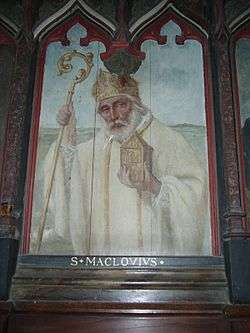Malo (saint)
| Saint Malo of Aleth | |
|---|---|
|
Saint Malo | |
| Born |
c. 27 March 501 (487 AD) Traditionally Gwent, Wales |
| Died |
15 November 621 (this may have been the death date of Saint Marcoult) Archambiac, Brittany |
| Venerated in |
Roman Catholic Church Eastern Orthodox Church |
| Major shrine | Saint-Malo Cathedral |
| Feast | 15 November |
| Attributes | Depicted as an abbot and a bishop |
| Patronage | Saint-Malo, pig-keepers, lost items |
Saint Malo [sɛ̃.ma.lo] (also known as Maclou or Mac'h Low, or in Latin as Maclovius or Machutus, born c. 27 March 520 – died 15 November 621) was a mid-sixth century founder of Saint-Malo, a commune in Brittany, France. He was one of the seven founding saints of Brittany.
Saint Malo of Aleth was baptized as an adult by Saint Brendan the Navigator. He became a student of Saint Brendan. As a monk at Llancarfan Abbey in Wales, Saint Malo was known for his participation in the famous Voyage of Saint Brendan. As an Immigrant to Brittany, he helped in the missionary work of Saint Aaron of Brittany, was the First bishop of Aleth (modern Saint-Servan, France) and established churches in the area of Brittany now named Saint-Malo in his honor. Saint Malo of Aleth was later driven from the area to Saintes, France by opponents of his mission.
Details of Malo's career have been preserved in three medieval 'Lives' that seem to include incidents associated with multiple people bearing a similar name. It appears that Saint Malo of Aleth was probably born in Wales in approximately 520.
Malo's name may derive from the Old Breton machlou, a compound of mach "warrant, hostage" and lou (or loh) "brilliant, bright, beautiful".[1]
Voyages with Saint Brendan
After his baptism, he became Brendan's favorite disciple.[2] He may have accompanied Saint Brendan on his famous voyage.
Saint Brendan and Malo left Llancarfan Abbey with several companions and discovered the "Island of the Blest". He then went to sea on a second voyage and visited the Island of Cézembre, remaining there for some time. During their travels, they encountered Maclovius, a dead giant whom Brendan temporarily revived with his holiness. Brendan baptized him before the giant returned to his grave.[3] It is thought that Brendan, on the occasion of his second voyage, evangelized the Orkney Islands and the northern isles of Scotland.
Breton evangelist
At Aleth, Malo served under a venerable hermit named Aaron. Upon Aaron's death in 544, Malo continued the spiritual rule of the district subsequently known as St. Malo and was consecrated as the first Bishop of Aleth.
In old age, the disorder on the island compelled Saint Malo to leave, but the people soon begged him to return. He obliged his people and returned to restore order. Feeling at the end of his life, the saint was determined to spend his last days in solitary penance. Accordingly, he went to Archambiac, a village in the diocese of Saintes, where he passed the remainder of his life in prayer and mortification. His death, reported in Archingeay (in the same diocese), came on November 15, 621 (although this may have been a different saint named Marcoult).
Veneration
The city of Saint-Malo is one of the seven stages in the Tro Breizh ("Tour of Brittany", in Breton), a pilgrimage celebrating the seven founding saints of Brittany.
Indirectly, the Spanish name of the Falkland Islands, Islas Malvinas, can be traced to Saint Malo, as it is derived from the French, Îles Malouines and named by Louis Antoine de Bougainville in 1764 after the first known settlers: mariners, and fishermen from the port of Saint-Malo.[4]
Pontoise Cathedral is dedicated to Saint Malo. Lesmahagow Priory in South Lanarkshire is also dedicated to him in the Latin form of his name, Machutus.
The place-name Saint-Maclou also refers to him.
References
- ↑ Léon Fleuriot, Les Origines de la Bretagne, ed. Payot, 1982, p. 150 and 281.
- ↑
 Herbermann, Charles, ed. (1913). "St. Machutus". Catholic Encyclopedia. New York: Robert Appleton Company.
Herbermann, Charles, ed. (1913). "St. Machutus". Catholic Encyclopedia. New York: Robert Appleton Company. - ↑ Ramsay, Raymond (1972). No Longer on the Map. New York: Viking Press. p. 81. ISBN 0-670-51433-0.
- ↑ "Falkland Islands Guide". Blog at Worldpress.com. Retrieved 6 March 2010.
- (English) St. Machutus (reference to Aaron)
- Sabine Baring-Gould. (1907). Lives of the British Saints.
See also
- Blessed Julian Maunoir, "Apostle of Brittany"
![]() This article incorporates text from a publication now in the public domain: Herbermann, Charles, ed. (1913). "article name needed". Catholic Encyclopedia. New York: Robert Appleton.
This article incorporates text from a publication now in the public domain: Herbermann, Charles, ed. (1913). "article name needed". Catholic Encyclopedia. New York: Robert Appleton.
